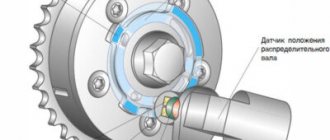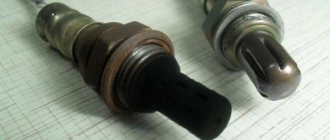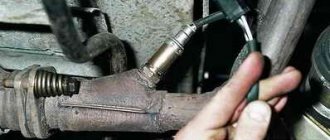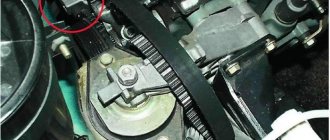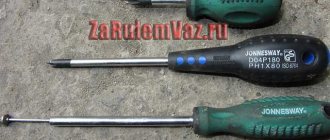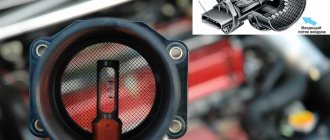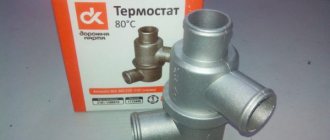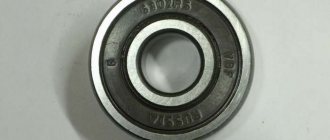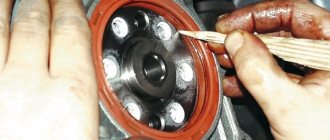Now it's time to change the DPKV. In theory, there is no particular point in making such an entry, but the Internet is replete with a lot of “symptoms”, at the same time, for some reason I have never seen the symptoms that manifested themselves in me anywhere. Everything described below will be based on simple facts about the operation of the machine, the maximum that will be used from the equipment is the BC (On-Board Computer). Inside I will insert simple little things in italics, they are needed for reference in order to avoid unnecessary questions.
Brief information
. DPKV is the most important sensor in the system. You simply won't eat without it. When it finally fails, you will have no spark at all. It is thanks to this sensor that the ECU “knows” what position the engine crankshaft is in. Based on this, injection and ignition are calculated. For example. Without a mass air flow sensor, the car will barely drive, it will stall, the idle will disappear, but the car will drive. No temperature sensor either. The motor stalls, not really working. Etc. and so on. But without DPKV it will not work at all. That's why I always have this sensor with me.
Over the entire life of the car, which is almost 11 years and almost 56,000 km. I changed the DPKV 2 times. So I came 3 times. All these replacements were combined with common symptoms. And like a carbon copy. I will try to describe them in as much detail as possible. I will describe them in the order of their appearance, i.e. in the beginning the one that appeared first.
Symptom No. 1
Occasionally, error No. 53 is stored in the ECU memory, the status is accumulated. Visible only by entry in BC.
Symptom No. 2
The error appears more and more often. After starting the engine, the error lamp may light up, but this does not affect the operation of the car in any way. Error 53 is still present and has accumulated status.
Symptom No. 3
The car takes a little longer to start. Those. You have to turn the starter longer, literally 1-2 turns. After startup, error No. 53 is consistently recorded in the ECU. Over time, the symptom progresses.
Symptom No. 4
The car may not start at some point.
After an unsuccessful start, error No. 53 is still accumulated in the ECU memory. The symptom also progresses over time. Read more: Jack Shaaz 5 t
Symptom No. 5
During operation, the engine may begin to shake, rare “misunderstandings” occur, and the engine loses speed. At this moment, CHEK lights up and goes out (the ECU again indicates error No. 53).
To sum it up. DPKV simply starts to work unstable. And during startup, when the speed is low and the voltage on the DPKV magnet is minimal, its malfunction more often manifests itself. No matter how you look at the DPKV magnet, its characteristics deteriorate over time, the readings have a large error, and the DPKV mark, like the rest of the teeth, has instability (clearly visible on an oscilloscope).
I didn't want to wait. And because I noticed that starting the car was accompanied by the inclusion of CHEK and the appearance of a DPKV error, I immediately decided to replace it.
Basically, I had a new DPKV in the trunk. I bought it a relatively long time ago. I don’t remember where and how, I remember that the manufacturer and the DPKV itself arranged for me. But still, I thought that I needed to buy a new one, put it in the trunk, and put the one that was riding with me. But while going shopping I saw the following. DPKV made with a sledgehammer. A lot of sloppy smelting, the wire going into the DPKV is not filled in and moisture can get into the DPKV itself. There is nothing really indicated on the packaging. The magnet is roughly processed and weakly magnetizes. In fact, it should hold the metal very tightly. The pull-out force should be noticeable. In the end, due to lack of time, I decided to install the one that was in the trunk. Here he is.
Vehicle camshaft sensor UMZ-4216
The UMZ-4216 camshaft position sensor is a device that allows you to determine the position of the gas distribution mechanism depending on the location of the crankshaft. It is used to regulate spark supply and fuel injection. The sensor transmits information to the electronic control unit, which determines the top dead center of the first cylinder and, depending on its location, supplies the fuel-air mixture.
If the DPRV is in a faulty state, then the machine will also work continuously and start when cold. But the adjustment of the fuel-air mixture injection and spark will be inaccurate, since the operation of the camshaft sensor will be replaced by the DCPV.
If the fuel and spark supply system is not configured correctly, this can directly affect the operation of the engine. The internal combustion engine may not operate correctly, oscillate and vibrate.
It is recommended to replace the DPRV every 100 thousand kilometers. Due to metal dust, exposure to bad roads and constant temperature changes.
Checking and replacing the ZMZ-406 synchronization sensor
The synchronization sensor is an inductive type (2612.1.113 Bosch or 406.3847113) installed on the front end of the engine at the bottom, on the right side and is designed to synchronize the operation of the control unit with the engine operating process.
The sensor is a bar magnet with a winding wound on top of it and enclosed in a housing made of high-strength plastic.
When the teeth of the synchronization disk pass past the end of the core, a signal appears at the sensor terminals, carrying information about the crankshaft speed, and two teeth missing from the synchronization disk cause a signal pulse, by which the control unit determines the top dead center (TDC) of the first cylinder.
If the synchronization sensor and its circuits fail, engine operation is impossible.
The control unit will store a fault code in its memory and turn on the KMSUD warning lamp on the dashboard.
Purpose and operating principle of DPKV
The function of the device is to determine the position of the engine cardan at a certain time for computer control of actuators and coordination of the functioning of the gas distribution system. It serves to ensure the formation of impulses from the (60-2) teeth of the disk, that is, it marks the rotation of the cardan on sector marks. The angular stroke of one tooth, together with the gap to the next, is equal to 6o of rotation of the cranked spindle. It functions in conjunction with a toothed circle located on the cardan pulley. The circle has 60 notches with 2 whole protrusions missing. The cutout on the circle serves as the starting point for the location of the crankshaft. The beginning of the 20th (behind the cutout) tooth (teeth numbering starts from the cutout clockwise) corresponds to TDC of the first or fourth cylinder.
The specificity of the action of the crankshaft sensor is the formation of an alternating current emf of a sinusoidal type in its coil when passing a metal tooth of a circle with protrusions near its end. In the middle of the protrusion (its rear cut) there is zero pulse amplitude. When passing the cutout of the gear circle, the device is silent. From this point the car computer starts counting. When the 20th notch of the ECU synchronization circle approaches, it marks the location of the pistons of the first or fourth pots at TDC. Thus, the car computer knows what is located where in the engine.
Failure of the DPKV leads to the engine stopping.
Attention! The crankshaft sensor is the most important sensor among all engine sensors. You need to have a intact, working, spare DPKV in your car.
Important sensor
All injection and some carburetor cars are equipped with a crankshaft position sensor (CPS) and its failure leads to the inability to start the engine and unstable operation. In order to determine the malfunction of the crankshaft position sensor, you need to know its structure and how it works.
What is the camshaft sensor responsible for and how to check it yourself
The camshaft position sensor (CPS) is used to determine the angular positions of the timing belt in relation to the position of the crankshaft. Signals from this sensor are sent to the engine ECU, which corrects fuel injection and ignition. The DPRV also works in conjunction with the crankshaft speed sensor.
Failures in the operation of the sensor on gasoline units, which manifest themselves in the absence of an impulse to the control unit, often do not allow the car engine to start. In diesel engines, starting can be difficult, but possible. The diesel engine will run and even restart after stopping, since the ECU receives pulses in parallel from the crankshaft speed sensor.
We also recommend reading the article about the design of the Hall sensor. From this article you will learn about the design, operating principles of the devices and their application on cars.
Purpose of the camshaft position sensor
The basis of the sensor for determining the position of the camshaft is the Hall effect. For this reason, the DPRV is also called a Hall sensor. The magnetic field in such a sensor changes at the moment when the magnetic gap closes.
Engine crankshaft position sensor device
The crankshaft sensor consists of:
- Housing – plastic or aluminum with receptive part
- Sensory lobe - made of a magnetic core and a copper wire solenoid on an insulating reel
- Flange – oval with hole for M6 bolt
- Communication wire – shielded, 610 mm long
- The connecting plug of the wire is three-pin, crimped with the wire.
Design options:
- The wire output of the domestic crankshaft position sensor is rotated 900 with respect to the line of the mounting hole.
- The wire outlet of the imported device is oriented in the other direction from the mounting hole.
Classification
Depending on what physical process is used to base the operation of the crankshaft sensor, there are three main types:
- Magnetic (inductive) - a signal is generated at the moment a special mark passes through the generated magnetic field, does not require separate power, and can act as a speed sensor. Quite easy to use.
- Operating on the basis of the Hall effect - the signal is formed by blocking the emerging field with a special synchronizing disk; it can additionally act as an ignition distributor. The accuracy of the obtained indicators is achieved due to the complex design.
- Optical - information for the ECU is generated by interrupting the optical flow, which results in a voltage pulse. Smoke or contamination may cause inaccurate results.
Symptoms of malfunctions
The main problems that indicate a breakdown of the DPRV are increased fuel consumption and a malfunctioning internal combustion engine. Also, a “Check” light comes on on the car’s dashboard and the car may periodically overheat from a running engine.
These problems may also indicate a breakdown of other elements, so it is recommended to conduct computer diagnostics and determine what the problem is based on the vehicle error code. If the error code indicates camshaft sensor 4216, then the first thing to do is check the wiring. Often the wires become oxidized and this is what causes the breakdown; after cleaning, the device begins to operate normally.
If the DPRV has not resumed its functional activity, then it is recommended to additionally inspect the signal disk and benchmark. If damaged or deformed, replace it.
Causes of failure
There are several reasons why a sensor can fail. Below is a list of reasons contributing to sensor failure:
- Aging;
- The magnet on the sensor is clogged;
- Mechanical shock to the sensor;
- Open circuit;
Let's look at each of the reasons in more detail.
Aging
This reason is caused by natural factors of aging of the sensor parts, that is, the scattering of plastic, exposure of the electrical connector into which moisture can enter and cause a short circuit.
Magnet clogged
The magnet is the main element of the sensor that takes readings. When it is clogged, various metal shavings often stick to the sensor head, making it difficult for the sensor to operate. In case of such a breakdown, it is necessary to clean the sensor head from chips.
Mechanical shocks
Impacts to the sensor are possible when driving on a gravel road, when stones from under the wheels fly everywhere. Such impacts can damage the plastic housing of the sensor or break the power supply wiring.
Open circuit power supply
This problem occurs quite often and is explained by aging there and improper laying of the wire during various repairs, such as replacing the timing belt, etc. Very often the wire is laid next to the exhaust manifold, which, with its high temperature, negatively affects the insulation of the wire, destroying it and damaging that very screen.
Where is the crankshaft sensor located?
This section indicates the location of the crankshaft sensor for engines 405, 406, 409, 4213, 4216. The specific installation point for the device is presented.
It is mounted in the front of the heart of the car, on the right, below on the protrusion of the front cover of the cylinder block. Attached with M6 hardware under head 10. The normal gap between its end and the tooth of the synchronization disk should be 0.5-1.2 mm. For stable operation, set the gap to 0.8 mm. To do this, you need to sand the device seat with sandpaper. The crankshaft sensor is connected to the wiring harness using a three-pin socket with a frame spring.
Where is the DPKV installed on the UMZ 4213, 4216 engine?
The crankshaft sensor is located in the front part of the engine, on the right, on the flange of the camshaft gear cover. The nominal gap between the end of the device and the tooth of the synchronization disk is in the range of 0.51-2 mm.
Video - review of the crankshaft sensor.
Replacing the crankshaft sensor on engines 406, 405, 409.
Replacing the crankshaft sensor on engines 406, 405, 409 is carried out in the following sequence:
- Loosen the nut to 13 and
Video - sequence of replacing the crankshaft sensor:
The original video can be viewed on my YouTube channel: Here
The inductive sensor ZMZ-406 (0 261 210113 or 406.3847113) for GAZ-3110 Volga, Gazelle-3302 cars is designed to determine the angular position of the crankshaft, synchronize the operation of the control unit with the engine operating process and determine its rotation speed.
The ZMZ 406 crankshaft sensor is an inductive coil 1 with a magnet 3 and a core 7. The sensor works in conjunction with a toothed synchronization disk 8 mounted on the crankshaft pulley.
Engine crankshaft sensor malfunctions
| Engine crankshaft sensor faults 409 | Remedies |
| 1. Unstable rotation of a heated engine at empty speed. The check lamp lights up randomly when the unit is operating. The computer self-test returns code 53. |
|
| 2. The gasoline engine does not start or starts and stops. The ECU diagnostic itself determines the damage code 53. | Explore:
|
| 3. The gasoline engine does not start, does not pick up. The ECU diagnostics itself does not register fault codes. When the number of revolutions of the cardan is “0” in the method of purging the cylinders with air (starter rotation of the engine with the throttle open. | Find out:
|
Note: There is a domestic cardan meter on the propulsion unit 409. The UAZ 31602 car ran more than 80,000. There are no complaints about the device. But I set the gap between its end and the sync disk to 0.8-0.9 mm.
Crankshaft position sensor errors
The table form shows the crankshaft sensor errors that are detected by the self-diagnosis of the vehicle's ECU.
| Error codes for electrical synchronization sensor 409.10 with Mikas 7.2: | ||
| Auto engine crankshaft error code 409 | Name of the breakdown | Circumstances of determination |
| 027 | Breakage of the crankshaft position device line | When turning the cardan |
| 028 | Damage to the electrical cardan position sensor network | When twisting the crankshaft |
| 029 | Defective crankshaft position sensor line | When turning the cardan |
| 053 | Broken wires of the electric cardan position sensor | When twisting the crankshaft |
crankshaft sensor UMZ 4216 — search on DRIVE2
Comparison of phase sensors UMZ 4216, ZMZ 405,406 - GAZ Gazelle.
Hello guys, I'm boiling, I'm tired of changing sensors
phases... In short, due to the low cost, I always bought
sensors
, to be honest, a rare g...o. Over the past 3 months I have changed 5 pieces.
Sensors DPKV, DPRV(DF), DTOZH, DD. — GAZ 31, 2.9 l., 1997.
This post will talk about some sensors
installed on the motor itself.
About their necessity, installation features.
DPKV
-
crankshaft
position sensor . The
crankshaft
position sensor is designed to estimate the rotation speed
the
crankshaft .
Crankshaft position sensor GAZelle Business
Yesterday evening I started having problems starting. The warmed up engine started on the second or third attempt. There were no longer any options for repairs at 17:00 outside the city, so there was nothing left to do but finish the work and, if possible, move towards the house.
Waterproofing the crankshaft sensor? — GAZ Gazelle, 2.9 l., 2008.
Sensor
The crankshaft
position is flooded again! It's like a curse! Once even after washing
The ECU reports " sensor
crankshaft
position » And how many times did I get up in the spring or
I once went to Umz
so. So there, as if a drop gets on the spark plug caps, that’s it.
P0336 Crankshaft Position Sensor Error
1. Check the wires and resistance of the sensor
crankshaft position
.
_ Resistance may change slightly as temperature increases. 2. The output signal of the sensor
should have an AC voltage amplitude of about 0.
Symptom of a faulty crankshaft sensor
One of the most important components of a modern car is the DPKV sensor
crankshaft
position , signs of malfunction of which signal the driver about the need for urgent repair of this unit.
Repair of UMP – 4216…
Sigurdja › Blog › Repair of UMP
–
4216
… Sigurdja last online 2 weeks ago.
the sensor was installed in the upper radiator hose
turn on the fan and set
the sensor
to a temperature of 97°-82°. Connected.
Injecting 417th. (Part 2) - GAZ 21, 2.4 l., 1967
(By the way, I forgot to write about the sensor
coolant temperature (CLT).
DTOZh is needed for the brain, but with it, if you take the wire to the arrow (pointer on the dashboard) from a braid of wires, the arrow will not work correctly. Therefore, we need 2 sensors
, one for the brains.
Overhaul of UMZ 4216
The guy advised me to look at the sensors
, brains and something else, the issue with the correct installation of the ignition was swept aside, because...
The marks on the crankshaft
and camshaft gears were definitely set correctly.
The guys took the engine brains to check, everything was ok, they changed all the sensors
.
Read more: What is the tire speed index?
Hooray! STARTED... and less than a year has passed! — KIA Sportage, 2.0 l., 2001.
Sensor
synchronization 35.3847 is designed to generate an electrical signal when the angular position of a special toothed disk mounted on the
engine
crankshaft .
The sensor
is used as part of a comprehensive engine control system.
How to check the Crankshaft Position Sensor (CPS)
Sensor
crankshaft position
- all about
the crankshaft
sensor It is very difficult to imagine a modern miracle of engineering - a car without an abundance of electronic systems.
Camshaft and crankshaft sensors ZMZ 406. - Community.
Good day everyone! If with sensors
temperatures and their manufacturers, everything is clear (except for the recommended 405226, there is nothing special to take), then with the above
sensors
I don’t know what to choose, the topic is not discussed, so I turn to the community.
Gazelle error 053. crankshaft position sensor malfunction
Good afternoon everyone. Tell me who is in the subject. Such an incident happened for two days in a row, I drove a gazelle 406 engine and had no complaints about the work. But on the third it didn’t start. When you turn the engine it catches periodically but refuses to work.
Report after updating the UMZ 4216 - GAZ software.
the UMZ
4216
software . saigak007 last online more than 1 month ago.
remove the terminal from the cable. from any sensor
.
...from the crankshaft camshaft
. Well, in short, there are a lot of them out there, choose which thread and find a good one.
DPKV from Gazelle - Great Wall Hover, 2.0 l., 2014
Let me start with the fact that I have
crankshaft
sensor .
In the summer I went to the seaside, took a sensor
and threw it into the Hover, thinking if I cut off some chips and twist them.
This is the only sensor
without which you can’t move. When ordering the variator, I ordered and.
Measure seven times (crankshaft position sensor) - UAZ 3160.
I decided to buy a new sensor
, try, and suddenly the long-standing glitch disappears, with a reluctance to start 5 minutes after turning off the warm engine, I’m already used to juggling the
crankshaft
position sensor , the only thing that helps.
Ignition system UMZ 4216
The electronic control unit receives reference signals from sensors
crankshaft position and
phases.
The UMZ
4216
ignition system is part of the engine control system and consists of an ignition coil, high-voltage wires, etc.
GAZ Gazelle UMZ 4216
Waterproofing
crankshaft
sensor ?
Colleague! Health to you and everything connected with you. I recently rode a Gazelle 3302 farmer 4x4 with a UMZ
4216
injector Euro 3 2012.
Question about the sensor on UMZ 4213; 4216 - Community "UAZ drivers".
I didn’t like UMZ
4216
or
UMZ
motor on
sensor
When will I get married ZMZ-40200M and ZMZ- 4216
and they will install it on the Volga to scribble over this problem.
In the 402, the crankshaft
do not fall out below the belly and therefore the block is more rigid.
We continue to assemble spare parts for UMZ 421. EvoTech camshaft - UAZ.
If the connecting rods and gears of the camshaft and crankshaft
can't be tuned, so here's the camshaft
Briefly from an article about the UMP
A274: “Usually a reduction in engine volume, all other things being equal
We need a camshaft for UMZ
4216
, we simply have nowhere to get normal spare parts.
limits of motion sensor operation for each
The sensor illumination has a number of parameters, the adjustment of which ensures its correct operation.
tilt angle and height
This parameter is adjusted through the hinges, which are structurally included in the scanning device. detector beams work in a cone-shaped area . Depending on the angle of inclination changes, the area will be detected. If the detection angle of the cone is too strong, then objects raised at a great distance will not be detected due to the well-insignificant sensitivity, but a blind zone will arise near it. If the angle is all the way down, the detection zone will become smaller.
angle In addition to the tilt, the height and position of the sensor should be correctly positioned. A position below the detection target, human height for example, will cause the detection cone to be directed parallel to the ground. higher The sensitivity, the higher the scanner can be positioned and the angle lower.
Illumination
With this parameter you can determine the level of darkness that is considered working. This parameter is called Settings. LUX motion sensor lighting installation is performed at different brightness levels. They determine the threshold for triggering. This is necessary so that it does not occur in twilight or insufficient lighting conditions. It is best to adjust its time when the threshold value occurs in the evening: brightness before dark.
Sensitivity
This parameter is called SENS on most sensors. It requires that it does not trigger the appearance of small animals. Adjusting this parameter is more difficult than others. The correct value can only be determined by trial and error. It is clear that it is not always clear whether the device triggered when a person passed by or Alone.
of the animal, one of the criteria for the need for its adjustment is too frequent inclusion. If it is not located in a place where people often walk, then this parameter should be reduced. There are also seasonal settings: transitions in winter SENS parameters will require modification in the summer. Outdoor operation may require annual adjustment of this time according to the season change parameter.
Setting by time
TIME The setting is most often determined by a range in minutes from 1 interval to 10. It determines the duration of time during which the sensor should apply current to the load after switching on. It is useful in two cases: if during the watch certain triggering events are too frequent or if necessary for a long time. Second. post-processing case, possible in a dark room, closet, for example. When a person enters it, the light automatically lights up and its operating time is sufficient to pick up the desired item.
the thing is the entrance to an ordinary apartment building . In the evening and morning hours people can pass by very often. To ensure that the light bulb does not burn out frequently from the switch with the motion sensor, the TIME parameter is adjusted to a value of 10 minutes. During the daytime, when the number of people passing by is small, the light bulb simply turns off. The result is a compromise of electricity: the option is not wasted, and the light bulb does not burn out.
How to check the crankshaft sensor?
To begin with, when removing it, we visually determine its integrity, whether the terminals on the power plug have oxidized. After that, we monitor it with device support. There are 3 methods for checking the synchronization device.
- 1.Control using an electrical tester:
We put the switch on the diode (Sound) and check the continuity between terminals 1 and 2, this is the positive and negative output to the sensor winding. If there is a break, there is no signal - the device is broken. The third terminal is connected to the shielded shell. When it shorts to other terminals, the DPKV is broken. - We turn on the tester for resistance readings and measure it at the sensor coil, between terminals 1 and 2. The readings should fall within the range of 650-750 Ohms. In this case, the device being tested is working.
- This test is more difficult than the previous one and strongly requires specific devices. The coil mounted in the DPKV, in the excited position, with the engine running, contains its own inductance. Which is what needs to be measured. For this you need to own the appropriate devices: mega ohmmeter;
- The most perfect way. With the support of this method, it is possible to see the controlled reading and see the sequence of impulse occurrence. DPKV testing can be performed on the engine and removed from it. An oscilloscope and software for it are required for testing. Testing the DPKV removed from the mover is performed in the proper order: Connect the oscilloscope contacts to the terminals of the DPKV coil. It doesn't matter which one is plus or minus
A gap in the oscillogram on a running car engine means the passage of the synchro disk near the DPKV in the place where 2 teeth are missing
Sensor check
The ZMZ 406 crankshaft sensor operates on the basis of the Hall effect and is installed in the end part of the cylinder head. Information about the position of the piston during compression, which is sent to the ECU, allows you to maintain the fuel injection sequence. A malfunction puts the entire fuel system into backup mode.
The following signs indicate the need to check the DPKV ZMZ 406:
- reduction in dynamic characteristics;
- speed changes for unknown reasons or “floats” in idle mode;
- physical exertion leads to detonation;
- the warning light on the instrument panel is on;
- the engine does not start.
Before checking the sensor, you should inspect the integrity of the housing, wires, connectors, and also make sure there is no debris or foreign parts. The presence of mechanical damage indicates a malfunction. If no visible damage is detected, the check can be performed in the following ways:
- Determination of winding resistance. A simple method that provides comprehensive information. To check, you will need a multimeter tester, which must be turned on in ohmmeter mode. For a working DPKV, the resulting value will be in the range of 800–900 Ohms.
- By measuring inductance. This method can be used if the multimeter has a built-in inductance test function. The obtained values should be in the range of 200–400 mH.
- Checking with an oscilloscope. This method will allow you to obtain complete information about the condition and operation of the sensor.
- Using an electrical circuit that you can assemble yourself. A short-term LED signal when a metal object approaches indicates serviceability.
- Install a new sensor and check engine operation.
The choice of diagnostic method depends on the availability of the necessary equipment.
Replacing the sensor
For convenience, it is advisable to remove the front right wheel and engine mudguard. Before replacing, it is necessary to prepare the tool. We will need:
- 10mm wrench;
- Powerful flat screwdriver;
Replacement process
- Disconnect the negative terminal from the battery;
- Remove the connector from the sensor;
- Unscrew the bolt fixing the sensor;
- We take out the DPKV using a screwdriver;
- We assemble the new sensor in the reverse order.
We hope our article was useful to you.
How to replace the Niva Chevrolet crankshaft sensor yourself
Required materials and tools:
- key to “10”;
- head, knob, knob extension;
- rags;
- additional lighting as needed;
- new DPKV;
- Phillips head screwdriver.
Also interesting: Niva Chevrolet knock sensor - Auto magazine MyDucato
Regulations:
- place the car on the inspection channel;
- secure the wheels with wheel chocks;
- squeeze the parking brake;
- from under the bottom of the car, unscrew the six bolts that secure the metal protection of the oil pan;
- Using a screwdriver, carefully pry up the block with terminals, remove it, and move it to the side;
- Unscrew the screw - the retainer from the sensor;
- remove the controller;
- We carry out troubleshooting of the seat, wipe it, clean it from residual dust and dirt;
- insert a new controller;
- screw it in and assemble the structure in reverse order.
DIY replacement completed. For a detailed step-by-step guide, watch the video.
